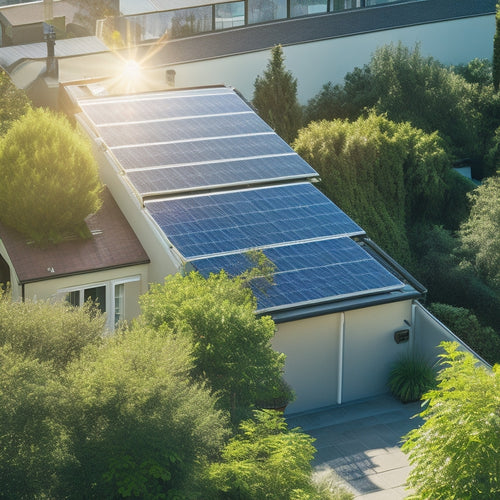
Lease to Save: A Small Business Guide
Share
As a small business owner, you're likely looking for ways to reduce energy costs and boost your bottom line. Solar leasing offers a sustainable solution, allowing you to tap into financial and environmental benefits without upfront costs. By leasing solar panels, you can access tax incentives, reduce your carbon footprint, and improve employee morale. You'll need to understand how solar leasing works, including lease agreements and maintenance standards. Analyze your costs to pinpoint savings opportunities and choose the right lease option for your business. Now, take the next step to discover how solar leasing can benefit your business.
Key Takeaways
• Tap into financial and environmental benefits of renewable energy through solar leasing, avoiding upfront costs and accessing tax benefits.
• Choose between fixed-rate and escalating-rate leases based on business goals and financial situation, ensuring high-quality equipment and maintenance standards.
• Conduct a cost savings analysis to pinpoint areas for cost reduction and increased ROI through leasing, identifying opportunities for savings on utility bills.
• Evaluate operating and capital leases for equipment acquisition, prioritizing effective asset management for optimal equipment performance and flexible payments.
• Opt for lease terms that align with business goals, negotiating a balance between flexibility and commitment, and reducing the risk of outdated equipment.
Benefits of Solar Leasing
By leasing solar panels, you can tap into the financial and environmental benefits of renewable energy without shouldering the upfront costs of purchasing and installing the system. This approach allows you to enjoy the advantages of solar energy while minimizing your upfront expenditure.
As a business owner, you can take advantage of tax benefits, such as the Solar Investment Tax Credit (ITC), which can substantially reduce your tax liability. Moreover, embracing renewable energy can boost your employee morale by demonstrating your commitment to sustainability and reducing your carbon footprint.
How Solar Leasing Works
When exploring solar leasing options for your small business, it's crucial to understand how it works. You'll want to begin by gaining an understanding of what solar leasing entails and how it varies from the traditional method of buying solar panels.
Following that, you should delve into the various types of lease agreements offered, including their terms, advantages, and potential disadvantages.
What Is Solar Leasing
You can think of solar leasing as a financing option that allows you to rent solar panels for a fixed period, typically 10 to 20 years, in exchange for a monthly payment. This approach guarantees common solar myths, offering a cost-effective way to harness renewable energy without the hefty upfront costs. Industry standards make sure that solar leasing companies provide high-quality equipment and maintenance, giving you peace of mind.
| Benefits | Leasing | Owning |
|---|---|---|
| Upfront Costs | $0 | $$$ |
| Maintenance | Included | Your Responsibility |
| Equipment Quality | High | Varies |
| Flexibility | Month-to-Month | Long-term Commitment |
Lease Agreement Types
Solar leasing companies typically offer two primary lease agreement types: fixed-rate and escalating-rate leases, each with its unique characteristics and benefits.
As you navigate lease negotiations, understanding these differences is important. Fixed-rate leases provide a stable, predictable monthly payment, which can be advantageous for budgeting purposes.
Escalating-rate leases, on the other hand, may offer lower initial payments that increase over time. You may be able to customize your lease terms through lease customization, tailoring the agreement to fit your business needs.
When entering lease negotiations, it's vital to take into account your business goals and financial situation to determine which lease type best suits you. By doing so, you'll be well on your way to securing a lease that supports your business's growth and success.
Cost Savings Analysis
By conducting a thorough cost savings analysis, businesses can pinpoint areas where leasing equipment or assets can help reduce expenses and boost their bottom line.
You can identify opportunities to cut costs and maximize your Return on Investment (ROI).
For instance, leasing energy-efficient equipment can lead to significant savings on utility bills, which can add up over time.
By analyzing your current expenses and identifying areas for improvement, you can make informed decisions about where leasing makes sense for your business.
With a clear understanding of your cost savings, you can create a more sustainable and profitable business model that sets you up for long-term success.
Lease Options for Businesses
When exploring lease options for your business, you'll want to evaluate the different types of leasing equipment options available. These may include operating leases or capital leases, each with their own benefits and drawbacks.
You'll also want to assess the financial lease benefits. These benefits may include reduced upfront costs and flexible payment structures.
Leasing Equipment Options
You have several lease options to contemplate when acquiring equipment for your business, each with its own benefits and drawbacks. When considering equipment financing, you'll want to weigh the pros and cons of each option.
One popular choice is an operating lease, which allows you to use the equipment for a set period while making regular payments. This option is ideal for businesses with limited budgets, as it provides flexibility and minimizes upfront costs.
On the other hand, a capital lease, also known as a finance lease, is more suitable for businesses that plan to use the equipment long-term. Effective asset management is important in both scenarios, as it ensures optimal equipment performance and reduces maintenance costs.
Financial Lease Benefits
Financial leases offer a range of benefits, including fixed monthly payments that can be tailored to fit your business's cash flow, allowing you to better manage your expenses and plan for the future.
With a financial lease, you'll enjoy:
-
Financial freedom: No large upfront costs or significant cash outlays, preserving your working capital.
-
Tax advantages: You can claim the lease payments as a business expense, reducing your taxable income.
-
Predictable expenses: Fixed monthly payments help you budget and forecast your expenses with ease.
- Flexibility: Financial leases often have flexible terms, allowing you to adjust to changing business needs.
Solar Panel Maintenance
Regular cleaning of your solar panels can boost their energy output by up to 21% and extend their lifespan.
As a small business owner, you want to guarantee your investment in solar energy pays off. To maximize energy efficiency, you should perform regular panel inspections. During these inspections, look for signs of dirt, debris, or damage that may be reducing your energy output.
Cleaning your panels every 6-12 months can greatly improve their performance. Additionally, inspecting your panels regularly can help identify potential issues before they become major problems.
Lease Term Flexibility
Three to five year lease terms are becoming increasingly popular among small business owners, as they offer a desirable balance between flexibility and commitment. You can negotiate a lease that suits your business needs, ensuring you're not tied down for too long. With a shorter lease term, you'll have more opportunities to reassess your equipment needs and adjust accordingly.
Consider the following benefits of lease term flexibility:
-
Customized duration: Choose a lease term that aligns with your business goals and equipment needs.
-
Early termination: You may have the option to terminate your lease early if your equipment needs change.
-
Flexibility for upgrades: Shorter lease terms allow you to upgrade your equipment more frequently.
- Reduced risk: You'll be less likely to be stuck with outdated equipment for an extended period.
Reducing Carbon Footprint
As a small business owner, you're likely aware of the importance of reducing your carbon footprint. By implementing eco-friendly operations and sourcing from a green supply chain, you can greatly minimize your environmental impact.
Green Supply Chain
By adopting sustainable practices in your supply chain, you can greatly reduce your company's carbon footprint and contribute to a more environmentally friendly business model.
One key aspect of a green supply chain is supply chain transparency, which involves tracking and monitoring your suppliers' environmental impact. This allows you to identify areas for improvement and make informed decisions about your partnerships.
To get started, consider the following strategies:
-
Optimize routes for sustainable logistics, reducing fuel consumption and emissions.
-
Choose eco-friendly packaging that minimizes waste and is fully recyclable.
-
Partner with suppliers who share your commitment to sustainability.
- Monitor and report on your supply chain's environmental impact to identify areas for improvement.
Eco-Friendly Operations
Implement eco-friendly operations to reduce your carbon footprint by evaluating and optimizing energy efficiency in your facilities, equipment, and daily business practices.
You can start by switching to energy-efficient lighting and appliances, and installing solar panels or wind turbines to generate renewable energy. Additionally, adopt eco-friendly packaging that's biodegradable, recyclable, or reusable to minimize waste.
Foster a sustainable workforce by promoting carpooling, using public transport, or encouraging remote work. You can also implement recycling programs, reduce paper usage, and encourage digital communication.
Government Incentives Available
You can take advantage of various government incentives designed to encourage entrepreneurship and economic growth, such as tax credits, grants, and low-interest loans. These incentives can help you save money and invest in eco-friendly operations.
Here are some government incentives you may be eligible for:
-
Tax Credits: Claim credits for investing in renewable energy sources, such as solar panels or wind turbines.
-
Renewable Grants: Apply for grants that support the development and implementation of renewable energy projects.
-
State Rebates: Take advantage of state-specific rebates for energy-efficient upgrades, such as installing LED lighting or energy-efficient HVAC systems.
- Federal Subsidies: Utilize federal subsidies for energy-efficient projects, such as retrofitting your building with energy-efficient windows.
Solar Leasing Case Studies
To illustrate the benefits of solar leasing, let's examine several real-world case studies that demonstrate how businesses like yours have successfully adopted solar energy while minimizing upfront costs.
You'll find inspiration in the success stories of companies that have already made the switch. For instance, a California-based winery reduced its energy costs by 50% after leasing a solar panel system. Similarly, a Massachusetts-based manufacturing firm saved over $200,000 in energy expenses over five years through a solar lease agreement.
Industry insights from these case studies reveal that solar leasing can provide a competitive edge, improve your bottom line, and enhance your brand reputation.
Getting Started With Leasing
With a clearer understanding of the benefits of solar leasing from real-world examples, it's time to take the next step and explore the process of getting started with a lease agreement that works for your business.
To guarantee a smooth changeover, you'll need to prepare your business for leasing. Here are some essential steps to take:
-
Lease Preparation: Review your business's financial history and credit score to determine your leasing options.
-
Financial Readiness: Gather financial documents, such as tax returns and bank statements, to demonstrate your business's financial stability.
-
Assess your energy needs and determine the ideal lease duration for your business.
- Research and compare leasing companies to find the best fit for your business.
Frequently Asked Questions
Can I Cancel My Lease if My Business Needs Change?
As you navigate business growth and change management, you're wondering if you can cancel your lease if your business needs change; the answer is, it depends on your lease terms and local laws, allowing for potential flexibility or penalties.
Are There Any Penalties for Early Lease Termination?
When you terminate a lease early, you'll likely face penalties, including early exit fees, which can be costly. However, some leases offer flexibility, allowing you to exit without incurring hefty fees, so review your contract carefully.
How Does Solar Leasing Affect My Business's Tax Liability?
"Ha! You thought solar leasing was all sunshine and rainbows? Not so fast! You'll be pleased to know that it can provide valuable tax deductions, bringing financial benefits to your business's bottom line, giving you more control over your finances."
Will I Own the Solar Panels at the End of the Lease?
At the end of the lease, you typically won't own the solar panels, but you'll have the option to purchase them at a discounted price. During the lease duration, you're usually not responsible for equipment maintenance, but you'll want to review your contract to confirm.
Can I Sell My Leased Solar Panels to Another Business?
You can't directly sell your leased solar panels, but you might be able to transfer the lease to another business through a lease transfer agreement, contingent on the leasing company's approval and a fair panel valuation.
Related Posts
-

How Solar Panels Reduce Electricity Bills
Solar panels can drastically cut your electricity bills by utilizing sunlight to generate your own energy. This decre...
-

Energy-Efficient Home Upgrades for Cost Reduction
To reduce costs with energy-efficient home upgrades, focus on essential improvements like smart thermostats, energy-e...
-

Solar Inverter Troubleshooting for Beginners
Troubleshooting your solar inverter starts with understanding its efficiency and performance metrics. Check for prope...


